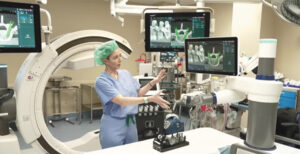By Amanda N. Sacino, MD-PhD . Neurosurgeon and Managing Partner
 Spinal stenosis is one of the most common and debilitating conditions affecting the aging population in the United States. Characterized by a narrowing of the spinal canal that compresses the spinal cord and nerves, it can lead to chronic back pain, numbness, weakness, and difficulty walking. For many patients, when conservative treatments such as physical therapy, injections, and medications fail, surgery becomes the most effective option to restore mobility and quality of life.
Spinal stenosis is one of the most common and debilitating conditions affecting the aging population in the United States. Characterized by a narrowing of the spinal canal that compresses the spinal cord and nerves, it can lead to chronic back pain, numbness, weakness, and difficulty walking. For many patients, when conservative treatments such as physical therapy, injections, and medications fail, surgery becomes the most effective option to restore mobility and quality of life.
Traditionally, spinal stenosis surgery—often in the form of laminectomy, decompression, or spinal fusion—has been performed using open surgical techniques or with the aid of fluoroscopic guidance. While effective, these methods carry risks such as blood loss, longer recovery times, and potential inaccuracies in implant placement. Today, robotic spine surgery is revolutionizing how spinal stenosis is treated, offering patients safer, more precise, and less invasive procedures.
Understanding the Role of Robotics in Spinal Stenosis Surgery
Robotic spine surgery integrates advanced imaging, navigation systems, and robotic technology to enhance a surgeon’s ability to operate with unmatched accuracy. Before surgery, high-resolution imaging such as CT scans is used to create a three-dimensional map of the patient’s spine. Surgeons then plan every detail of the procedure, including the exact placement of screws, rods, and decompression pathways.
During the operation, a robotic arm guides instruments along these preplanned trajectories. Unlike autonomous machines, the robot does not act independently; the surgeon remains in full control. The robotic system simply ensures that every movement is executed with submillimeter precision. This guidance is particularly critical in spinal stenosis cases, where the spinal canal is already narrowed and the margin for error is extremely small.
Benefits of Robotic Spine Surgery for Spinal Stenosis
1. Improved Accuracy and Safety
Spinal stenosis surgery often involves decompression of the nerves combined with stabilization of the spine using screws and rods. Incorrect placement of implants can risk nerve damage or instability, which may worsen symptoms rather than improve them. Robotic assistance significantly increases the accuracy of screw and implant placement, reducing the risk of complications and improving long-term stability.
2. Minimally Invasive Approach
Many patients with spinal stenosis are older and may have other medical conditions that increase surgical risk. Robotic systems make it easier for surgeons to perform minimally invasive procedures, which require smaller incisions and cause less disruption to muscles and soft tissue. For patients, this translates into reduced blood loss, shorter hospital stays, less postoperative pain, and faster recovery.
3. Reduced Radiation Exposure
Traditional spinal stenosis surgeries often rely heavily on fluoroscopy, exposing both the patient and the surgical team to significant amounts of radiation. With robotic guidance, the need for continuous fluoroscopy is dramatically reduced. This is particularly beneficial in multi-level stenosis cases, which otherwise require prolonged imaging.
4. Consistent, Reproducible Results
Robotic technology helps eliminate some of the variability that naturally occurs in traditional surgery. Every spinal stenosis case is unique, with differences in anatomy, severity of stenosis, and presence of instability. Robotics allows surgeons to consistently execute the surgical plan, regardless of these variations, leading to more predictable and reliable outcomes.
Patient Outcomes and Quality of Life
For patients suffering from spinal stenosis, the goal of surgery is straightforward: relieve pressure on the nerves, reduce pain, and restore mobility. Robotic-assisted spine surgery is delivering on these goals more effectively than ever before.
Patients undergoing robotic-assisted decompression and fusion procedures for stenosis often report quicker improvements in leg pain and walking tolerance
compared to traditional surgery. Shorter hospital stays and faster return to daily activities are especially valuable to older patients, who may otherwise face prolonged recovery periods. Moreover, by improving surgical accuracy and reducing complications, robotic systems help lower the likelihood of revision surgeries, sparing patients from additional procedures and recovery time.
Growing Adoption Across the United States
Robotic spine surgery was once limited to a handful of specialized centers, but it is now spreading rapidly across the United States. Systems such as the Globus ExcelsiusGPS are increasingly available in both academic hospitals and community medical centers. As more surgeons become trained and proficient in robotic techniques, the option of robotic-assisted treatment for spinal stenosis is becoming more widely accessible to patients. Last year, Physician’s Regional Collier Boulevard Hospital became the first hospital in the county to have a robotic neurosurgery program with the acquisition of the Globus ExcelsiusGPS system.
The Future of Spinal Stenosis Treatment
Looking ahead, the role of robotics in treating spinal stenosis will only expand. Advances in artificial intelligence and machine learning may allow robotic systems to adjust surgical plans in real-time, further personalizing procedures for each patient’s anatomy. Integration with augmented reality could enhance surgeon visualization during decompression, while improvements in robotic hardware will make systems more compact and efficient.
Most importantly, patients are increasingly aware of robotic options and are seeking out surgeons and centers that offer this technology. As awareness and demand grow, robotic spine surgery will continue to shape the future of spinal stenosis care in the United States.
239-422-APEX (2739)
3530 Kraft Road, Suite 203 • Naples, FL 34105
www.apexbrainandspine.com







